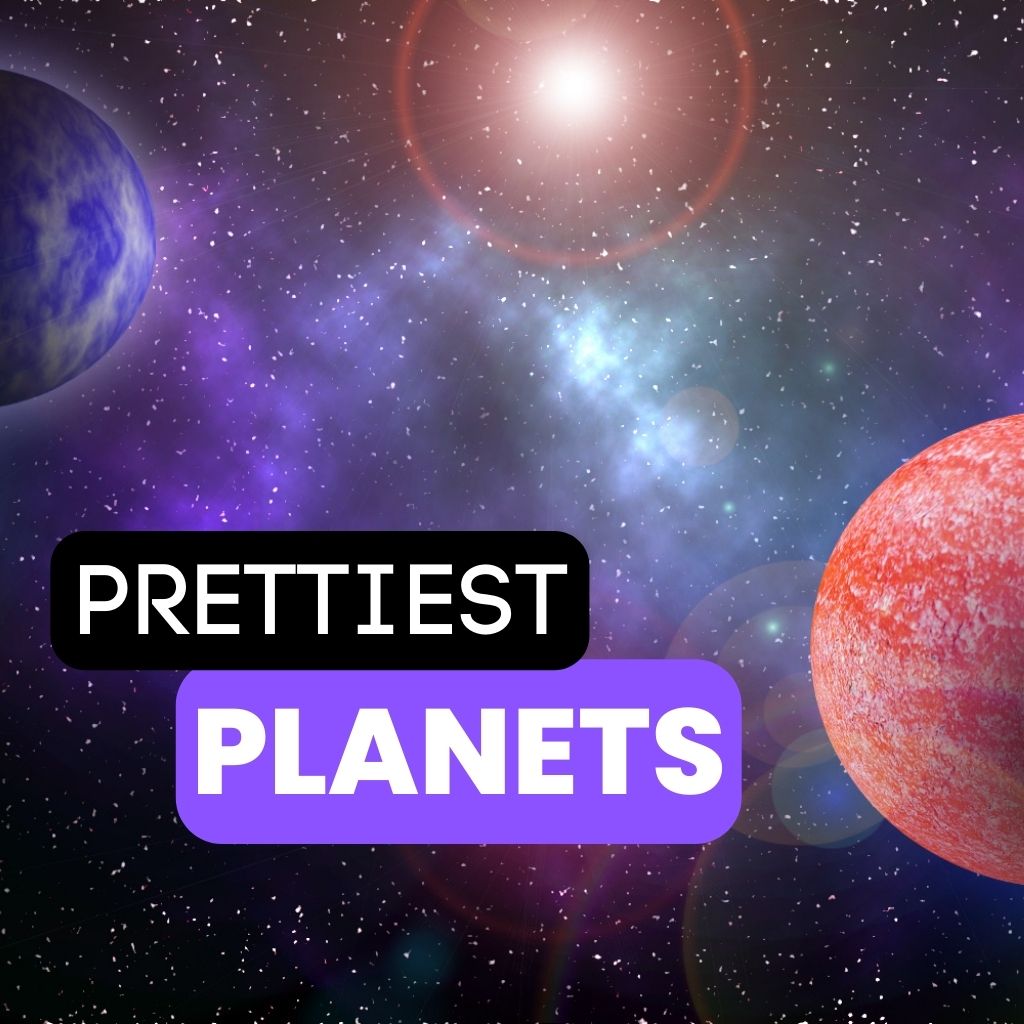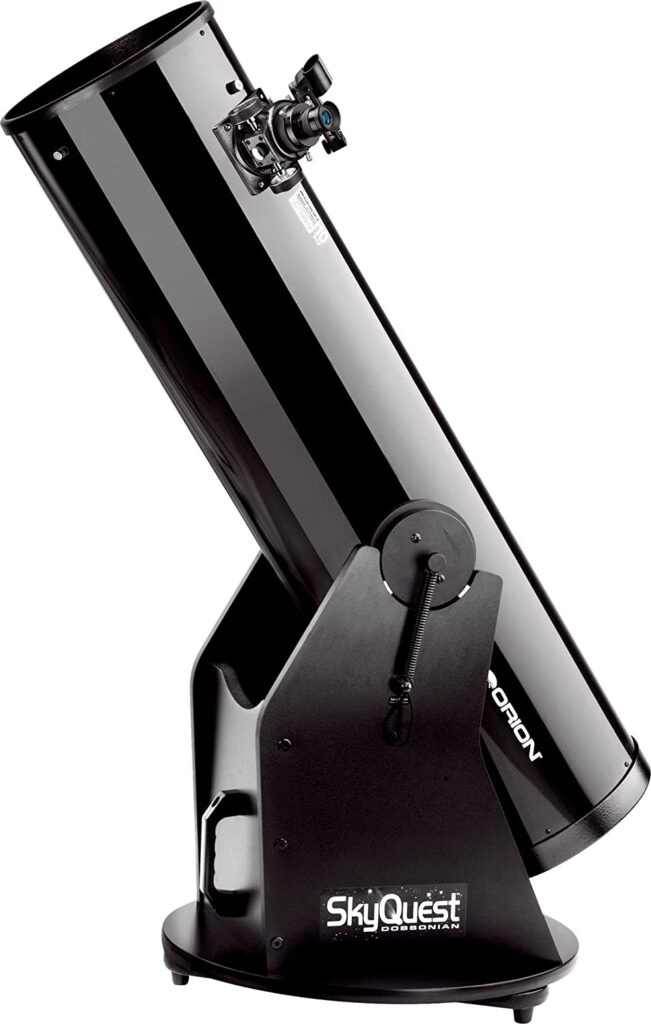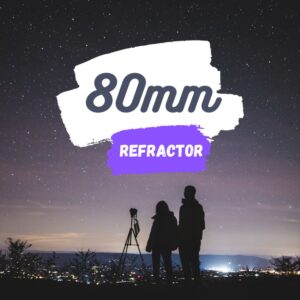This site contains affiliate links to products. I may receive a commission for purchases made through these links.
In this article, we will unveil a carefully curated list of the prettiest planets in the universe, each possessing its unique allure and captivating features.
1. Jupiter
Jupiter, the largest planet in our solar system, has a beautiful array of visual features that make it a captivating sight to behold. Its most prominent feature is the intricate system of atmospheric bands consisting of different colored clouds.
These bands, including shades of white, red, brown, and orange, create a mesmerizing tapestry of colors across the planet’s surface. The iconic Great Red Spot, a massive storm system larger than Earth itself, adds to the planet’s allure.
Jupiter’s four largest moons, known as the Galilean moons (Io, Europa, Ganymede, and Callisto), are easily visible alongside the planet, providing further beauty and intrigue.
Jupiter can be observed with a telescope. Even small telescopes can reveal the planet’s distinct cloud bands and the Galilean moons.
Recommended telescopes for observing Jupiter include the beginner-friendly Celestron PowerSeeker 127EQ, which offers a good balance of affordability and performance. The 127mm aperture and 1000mm focal length provide sufficient light-gathering capabilities to view Jupiter’s distinctive features, such as its cloud bands and the Great Red Spot.
For a more advanced option, the Celestron NexStar 8SE provides enhanced clarity and allows for detailed views of the planet’s atmospheric features and moons. Equipped with high-quality optics and a Schmidt-Cassegrain design, the Celestron NexStar 8SE delivers sharp and clear images of Jupiter’s cloud bands, Galilean moons in greater detail, atmospheric belts, and turbulent storms, such as the Great Red Spot.
Observing Jupiter during a clear night using these telescopes can provide a truly beautiful experience.
You may also like: 11 Best Telescopes to See Jupiter (Planet, Red Spot, and Moons)
2. Saturn
Saturn, often referred to as the “Jewel of the Solar System,” is renowned for its iconic and majestic ring system. These rings, composed of countless particles of ice and rock, create a breathtaking visual spectacle unlike any other planet. The rings exhibit intricate details, including gaps, divisions, and even waves caused by the gravitational interaction with Saturn’s moons.
The planet itself showcases a pale yellow color with subtle banding similar to Jupiter but less pronounced.
Observing Saturn through a telescope offers a remarkable opportunity to witness the splendor of its ring system and explore its atmospheric features. The ring structure appears as a thin, delicate structure encircling the planet, creating a truly mesmerizing sight.
To observe Saturn’s beauty, several telescopes offer great capabilities for capturing the planet’s interesting features, such as the Celestron AstroMaster 114EQ.
With its 114mm aperture and 1000mm focal length, this telescope delivers clear and detailed views of Saturn’s iconic rings and its prominent features, such as the Cassini Division and atmospheric banding.
Another noteworthy telescope for observing Saturn is the Orion SkyQuest XT6 Classic Dobsonian. This telescope features a larger aperture of 150mm and a focal length of 1200mm.
When observing Saturn, it is beneficial to use filters specifically designed for planetary observations. A polarizing filter, such as Orion 1.25″ Variable Polarizing Filter, or a color filter, such as Celestron 1.25″ Eyepiece and Filter Kit set, is recommended.
They can help enhance the contrast and bring out finer details on Saturn’s surface and atmosphere, allowing for a more immersive viewing experience.
You may also like: What Telescope Size Do I Need to See Saturn?
3. Mars
Mars, often referred to as the “Red Planet,” captivates with its rusty-red coloration and distinct surface features. Its reddish hue arises from iron oxide, or rust, present on its surface.
Mars showcases a diverse landscape, including dark regions known as “maria,” dusty plains, and prominent features such as the polar ice caps and towering volcanoes.
As a rocky planet, it has captivated scientists and space enthusiasts with its potential for past or present signs of life.
Observing Mars through a telescope reveals fascinating details that add to its allure. Depending on its position in its orbit, Mars may display polar ice caps and dark surface markings, such as Syrtis Major, a prominent dark region.
During rare dust storms, the planet’s surface features may become less visible. Nonetheless, the reddish tint and unique surface characteristics remain captivating.
To catch a glimpse of Mars and explore its fascinating features, Celestron AstroMaster 70AZ allows for decent magnification and clear views, enabling observers to observe the planet’s distinct coloration and potentially detect some surface features.
For those seeking an upgrade to enhance clarity and detail, the Sky-Watcher 8″ Dobsonian telescope is a good choice. With its larger 8-inch aperture, this telescope collects more light, resulting in improved image resolution and the ability to discern finer details on Mars.
For advanced observers seeking exceptional performance in capturing high-resolution views of Mars and its surface features, the Celestron NexStar 9.25 Evolution is a top recommendation.
The computerized GoTo mount of the Celestron NexStar 9.25 Evolution aids in accurately tracking Mars as it moves across the night sky, ensuring a steady and immersive viewing experience.
You may also like: What Telescope Size Do I Need to See Mars?
4. Earth
Earth as seen by the Apollo 17 crew traveling toward the moon
Earth, our blue gem floating in the vastness of space, boasts an incredible array of natural wonders. From the majestic peaks of the Himalayas to the serene beaches of the Maldives, our planet is adorned with breathtaking landscapes that evoke a sense of admiration.
The vibrant colors of our diverse ecosystems, the power of thundering waterfalls, and the intricate formations of canyons and caves all contribute to the unparalleled beauty of Earth. Earth’s Moon, being the only moon on our planet, holds a special place in our solar system.
What sets Earth apart from other planets is the existence of life in all its forms. It is the only planet with human life.
Our planet teems with a rich tapestry of biodiversity, from the lush rainforests teeming with exotic creatures to the vibrant coral reefs brimming with life beneath the ocean’s surface.
The ever-changing interplay of seasons and the stunning dance of light in the auroras further enhance Earth’s natural splendor. However, as we appreciate the beauty of Earth, we must also recognize the importance of preserving and protecting it. Our planet faces numerous challenges, including climate change, habitat destruction, and pollution.
We must work collectively to ensure the continued preservation of Earth’s natural beauty for future generations to behold and cherish.
5. Venus
Venus, often referred to as Earth’s “sister planet,” possesses a serene beauty. Shrouded in a thick atmosphere composed mainly of carbon dioxide, Venus exhibits a brilliant white appearance, reflecting sunlight with exceptional brightness. Its cloud layers, consisting of sulfuric acid, create a delicate and hazy veil, adding to the planet’s ethereal charm.
Although we may not be able to witness its beauty firsthand, the artistic renderings and scientific interpretations provide us with glimpses into its potential splendor.
Observing Venus with a telescope can reveal its phases, similar to those of the Moon, as it orbits the Sun. However, due to its proximity to the Sun, Venus is challenging to observe during the day.
It is best observed during dawn or dusk when it is higher in the sky. As Venus appears as a bright point of light, telescopes such as Celestron NexStar 4SE, with its high-resolution capabilities, allow you to witness the phases of Venus, as well as its cloud patterns and atmospheric features.
You may also like: 11 Interesting Venus Facts for Kids (Explained!)
6. Uranus
Uranus, the seventh planet from the Sun, exhibits a striking blue-green coloration due to the presence of methane in its atmosphere. Although less visually distinct than Jupiter or Saturn, Uranus possesses a unique beauty characterized by its subtle pastel hues and its enigmatic nature.
Observing Uranus with a telescope allows you to appreciate its pale blue-green disk and potentially glimpse its faint ring system. Celestron NexStar 6SE’s larger aperture allows for increased light gathering, enabling observers to see the unique bluish-green color of Uranus and potentially catch a glimpse of its faint rings and some of its larger moons.
Orion SkyQuest XT10i IntelliScope Dobsonian is another good option. This Dobsonian telescope has a larger 10-inch aperture, providing enhanced light-gathering capabilities for detailed views of Uranus.
This telescope is ideal for experienced observers seeking high-resolution views of Uranus and its subtle features, such as cloud banding and possible atmospheric variations.
7. Neptune
Neptune, the most distant planet in our solar system, exhibits a captivating deep blue coloration. Similar to Uranus, Neptune’s atmosphere contains methane, which absorbs red light, resulting in its distinctive blue appearance. The planet showcases subtle cloud bands and occasional dark storms, including the famous Great Dark Spot.
Neptune, being one of the outermost planets in our solar system, is not typically visible to the naked eye. Its distant location and relatively dim appearance make it challenging to spot without the aid of a telescope. However, with the right equipment, you can observe Neptune and its beautiful features.
The Sky-Watcher EvoStar 120mm allows for detailed views of Neptune. Its compact and portable design makes it convenient for both backyard and remote observations.
This telescope offers an affordable option for intermediate observers seeking enhanced views of Neptune’s bluish disc and potential atmospheric features.
You may also like: What Size Telescope Do I Need to See Neptune? (Answered!)
8. Kepler-186f
Kepler-186f is an exoplanet located around 500 light-years away in the constellation Cygnus. It is considered an exciting discovery due to its potential Earth-like characteristics.
Kepler-186f orbits its star within the habitable zone, where conditions for liquid water may exist.
While the direct observation of Kepler-186f with telescopes is currently not feasible, its existence was determined through the transit method, which detects slight changes in the host star’s brightness as the planet passes in front of it.
9. TRAPPIST-1e
TRAPPIST-1e is part of the TRAPPIST-1 system, situated approximately 39 light-years away in the Aquarius constellation. This rocky exoplanet is of particular interest because it resides within the habitable zone of its star.
Scientists speculate that TRAPPIST-1e may have a favorable environment for supporting liquid water, making it a potential candidate for habitability.
While direct visual observation of TRAPPIST-1e is not currently possible, its detection and characterization were achieved using the transit method. It is important to acknowledge that our understanding of the universe is ever-evolving, and new discoveries about this planet await us.
10. HD 189733b
Located roughly 63 light-years away in the constellation Vulpecula, HD 189733b is a gas giant exoplanet known for its mesmerizing deep blue color.
This captivating hue is attributed to the scattering of blue light in its atmosphere. However, HD 189733b is inhospitable and not suitable for life.
Due to its proximity to its host star and its atmospheric conditions, direct telescopic observation of HD 189733b’s visual features is challenging.
Studying this planet allows us to expand our understanding of planetary formation, atmospheric dynamics, and the conditions that may support life.
11. WASP-12b
WASP-12b is an exoplanet situated around 1,400 light-years away in the constellation Auriga. What makes this gas giant notable is its exceptionally dark appearance.
It exhibits a low albedo, absorbing approximately 94% of the light that reaches it. Despite its intriguing nature, direct telescopic observation of WASP-12b’s physical characteristics is limited.
12. Kepler-452b
Located approximately 1,400 light-years away in the constellation Cygnus, Kepler-452b is often referred to as Earth’s “cousin” or “older sibling.”
It is a rocky exoplanet that orbits a star similar to our Sun. Kepler-452b resides within the habitable zone and has a slightly larger orbit than Earth.
While the direct observation of Kepler-452b is challenging, its discovery through the transit method has provided valuable insights into the potential for Earth-like exoplanets in our galaxy.
13. Proxima Centauri b
Proxima Centauri b is an exoplanet located only around 4.2 light-years away, making it the closest known exoplanet to our solar system. It orbits Proxima Centauri, a red dwarf star, within its habitable zone.
Although the direct visual observation of Proxima Centauri b is currently beyond our technological capabilities, its existence was detected using the radial velocity method, which measures the wobble of the star caused by the gravitational tug of an orbiting planet.
As technology progresses and our knowledge expands, we can look forward to unraveling even more breathtaking parts of this planet and expanding our appreciation for the boundless beauty that exists beyond our home planet.
Takeaway: Beautiful planets exist within and outside our solar system
These beautiful planets captivate our imagination and remind us of the breathtaking wonders that exist in the universe.
Jupiter and Saturn, as gas giant planets, exhibit their own unique beauty. Neptune, with its mesmerizing deep blue coloration, is truly a beautiful planet. Venus, with its thick atmosphere and extreme temperatures, is an interesting planet worth exploring. Kepler-186f, an exoplanet located in the habitable zone of its star, holds the potential to be an Earth-like planet with conditions suitable for life. Uranus, with its tilted axis and peculiar rotational characteristics, is a strange planet among its counterparts.
In the pursuit of knowledge and the quest to explore the vastness of space, the prettiest planets in the universe serve as a reminder of the enchanting wonders that await our discovery.
They inspire us to continue pushing the boundaries of scientific exploration, fueling our passion for uncovering the remarkable treasures that lie scattered across the cosmos.
You may also like:














